Scenic American Landscapes
Introduced in 1993, the Scenic American Landscapes picture the “mountains, canyons, and swamps that comprise our country’s diverse and majestic terrain,” according to the USPS. Each stamp was issued to satisfy the International Rate applicable at the time of its release.
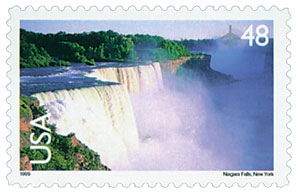
1999 Niagara Falls
This stamp was issued in 1999 to pay the international postage rate. It is the first stamp in the Scenic American Landscapes Series. The stamp features a photo of the American Falls taken from the New York shoreline by nature photographer Kurt Ross. To the left of the stamp’s denomination is the stylized silhouette of a jet, which indicates it was intended to satisfy an airmail or international rate.
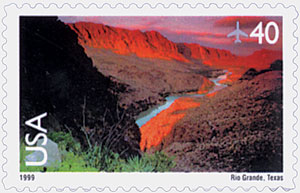
1999 Rio Grande
The second installment in the Scenic American Landscapes Series pictures the Rio Grande River, which marks the boundary between Texas and Mexico. The 40¢ denomination of this stamp fulfilled the 1999 international rate for a postcard mailed from the United States to Mexico.

2000 Grand Canyon
The third Scenic American Landscapes Series stamp shows a photographic panorama of the Grand Canyon. Initially, the 60¢ stamp was incorrectly inscribed, “Grand Canyon, Colorado.” The error was caught before any stamps were released. Over 100 million stamps had to be destroyed. The corrected inscription reads, “Grand Canyon, Arizona,” since the entire Grand Canyon is within that state. This 2000 issue was intended for letters up to one ounce and mailed to Canada or Mexico.
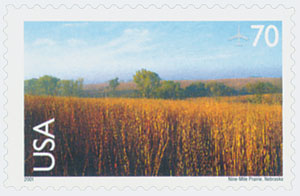
2001 Nine-Mile Prairie
The fourth stamp in the Scenic American Landscapes Series pictures the sweeping tall grasses of Nine Mile Prairie. Most of this 230-acre prairie north of Lincoln, Nebraska, has never been plowed. Owned by the University of Nebraska Foundation, it has been preserved for nature study, teaching, and research. The 70¢ stamp was issued in 2001 to pay the international postcard rate to countries other than Mexico and Canada.
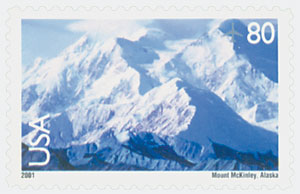
2001 Mt. McKinley
Named for President William McKinley, Mount McKinley graces the fifth stamp in the Scenic American Landscape Series. The mountain is located in Alaska’s Denali National Park and Preserve. At 20,320 feet, it is the highest mountain in North America. The 80¢ stamp was issued in 2001 for letters weighing up to and including one ounce and mailed to all countries other than Canada and Mexico.
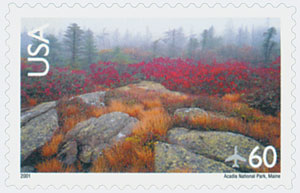
2001 Acadia National Park
The sixth Scenic American Landscapes Series stamp features Acadia National Park, which includes 45,000 acres of mountains, lakes, forests, and rocky shoreline in Maine. Acadia was the first national park created east of the Mississippi River. This 60¢ stamp, issued in 2001, replaced the 60¢ Grand Canyon stamp for letters weighing up to and including one ounce and being mailed to Canada or Mexico.
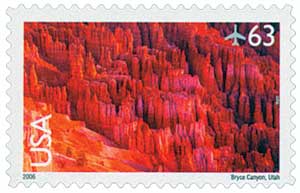
2006 Bryce Canyon National Park
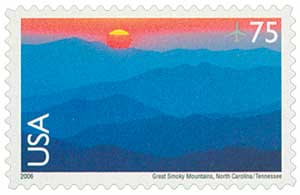
2006 Great Smoky Mountains National Park
The eighth Scenic American Landscapes Series stamp features the Great Smoky Mountains that lie in the Southern Appalachian Mountains of North Carolina and Tennessee. Among the oldest mountains in the world, they support an amazing diversity of life. The Great Smoky Mountains were also pictured in the 1934-35 National Park Series stamps. Seventy-five cents paid the card rate for countries other than Mexico and Canada in 2006.
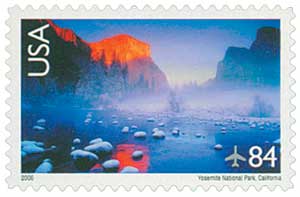
2006 Yosemite National Park
Yosemite, located in California, is shown on the ninth installment of the Scenic American Landscapes Series. This stamp satisfied the international letter rate in 2006. Yosemite is best known for its spectacular waterfalls, giant sequoia groves, and granite cliffs. Yosemite’s granite formation “El Capitan” was featured in the 1934-35 National Park Series stamps.
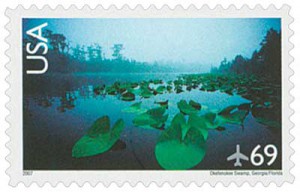
2007 Okefenokee Swamp
One of the “Seven Natural Wonders of Georgia,” the Okefenokee Swamp is the biggest swamp of its kind in North America. The 438,000-acre peat-filled wetland is home to a number of wading birds including herons, egrets, ibises, cranes, and bitterns. Wildlife such as alligators and black bears also inhabit the swamp.

2007 Hagatna Bay
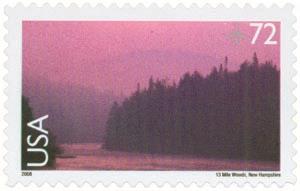
2008 13-Mile Woods
13-Mile Woods is a community forest preserve located in northern New Hampshire. Remote and unspoiled, the woods have been conserved by the residents of Errol, New Hampshire, and the nonprofit Trust for Public Lands. The 13-Mile Woods consist of 5,300 acres of mature hardwood and softwood trees, as well as nine miles of frontage along the Androscoggin River. A sunrise in the 13-Mile Woods was captured by Jerry and Marcy Monkman.

2008 Trunk Bay
St. John, one of the four main United States’ Virgin Islands, was discovered by Christopher Columbus in 1493. On March 25, 1718, Danish planters established the first permanent European on St. John at Coral Bay. Ownership was finally transferred to the U.S. in 1917. Every year, millions of visitors are drawn to St. John’s breathtaking beaches and its tropical climate. Nearly half of the island is part of the Virgin Islands National Park. Trunk Bay, located here, is featured on the 2008 U.S. 94¢ stamp, the thirteenth in the Scenic American Landscape Series.
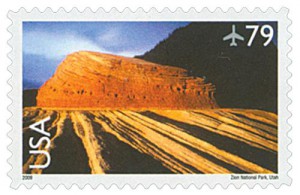
2009 Zion National Park
The Park was first recognized in 1909, when President William Howard Taft proclaimed the region the Mukuntuweap National Monument. Congress renamed it Zion in 1919, and made the area into a National Park. Zion celebrated its 100-year anniversary in 2009 and now attracts nearly three million visitors yearly.
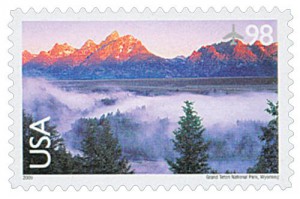
2009 Grand Teton National Park
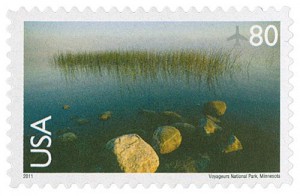
2011 Voyageurs National Park
Voyageurs National Park in Minnesota was established in 1975. The 218,000-acre park contains more than 344 square miles of water, including four major and 30 smaller lakes. The park preserves “the historic route of the voyageurs who contributed significantly to the opening of the northwestern United States.”
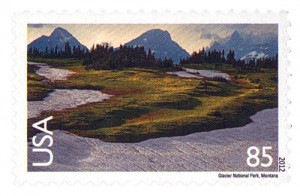
2012 Glacier National Park
George Bird Grinnell knew the “Crown of the Continent” was a treasure worth preserving, so he worked for 20 years to safeguard its beauty. His diligence paid off on May 11, 1910, when the Crown, 1.4 million acres in Montana, was designated as Glacier National Park.

2012 Lancaster County
Lancaster County, the center of “Pennsylvania Dutch Country,” a popular tourist destination, is known as the “Garden Spot of America.” This was the last stamp in the Scenic American Landscapes Series.

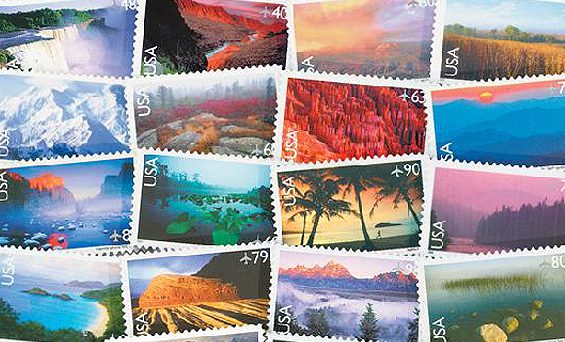
In 2005 the Acadia stamp was reissued with a new year date. Scott could have given it a new “C” number. In any case the Lancaster $1.05 issue, is considered the last U.S. airmail stamp. The first Global Forever issue, without an image of an aircraft, soon replaced it.